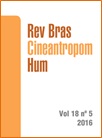Obesidade em adolescentes do Sul do Brasil: associação com fatores sociodemográficos, estilo de vida e estágio maturacional
DOI:
https://doi.org/10.1590/1980-0037.2016v18n5p557Resumo
O excesso de adiposidade corporal está associado a doenças crônicas degenerativas, sendo problema global de saúde pública. O objetivo do estudo foi verificar a associação da obesidade com fatores sociodemográficos, estilo de vida (atividade física, hábitos alimentares) e maturação sexual em estudantes do ensino médio de uma cidade do sul do Brasil. Estudo transversal com 820 adolescentes de escolas públicas de São José, Santa Catarina, Brasil, com idade de 14 a 17 anos. A obesidade foi estimada por meio do percentual de gordura corporal (%G). O %G foi calculado por meio da equação de Lohman que considera o somatório de dobras cutâneas (Tríceps e Subescapular). Usou-se os pontos de corte proposto por Willian et al. para classificar os jovens em eutróficos ou obesos. As variáveis independentes foram sexo, idade, nível econômico, escolaridade dos pais, hábitos alimentares, nível de atividade física e maturação sexual. A prevalência de obesidade foi de 17,2%. O sexo feminino (OR: 4,22; IC95%: 2,72-6,54) e os jovens no estágio pós-púbere de maturação sexual (OR: 1,95; IC95%:1,33-2,86) apresentaram maiores chances de obesidade. Estes resultados podem auxiliar as autoridades do município para o planejamento de políticas públicas de prevenção a obesidade.
Downloads
Publicado
Edição
Seção
Licença

Direitos Autorais para artigos publicados nesta revista são do autor, com direitos de primeira publicação para a revista. Em virtude da aparecerem nesta revista de acesso público, os artigos são de uso gratuito, com atribuições próprias, em aplicações educacionais e não-comerciais, desde que seja dada a atribuição. Esta obra foi licenciada com uma Licença Creative Commons Atribuição 4.0 Internacional - CC BY


